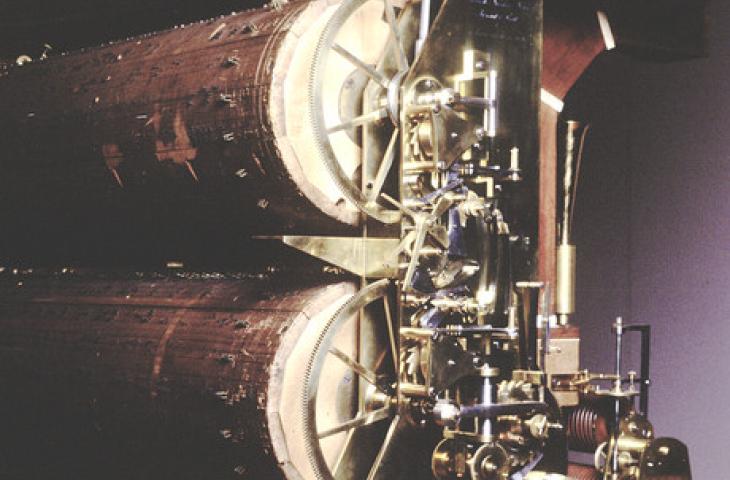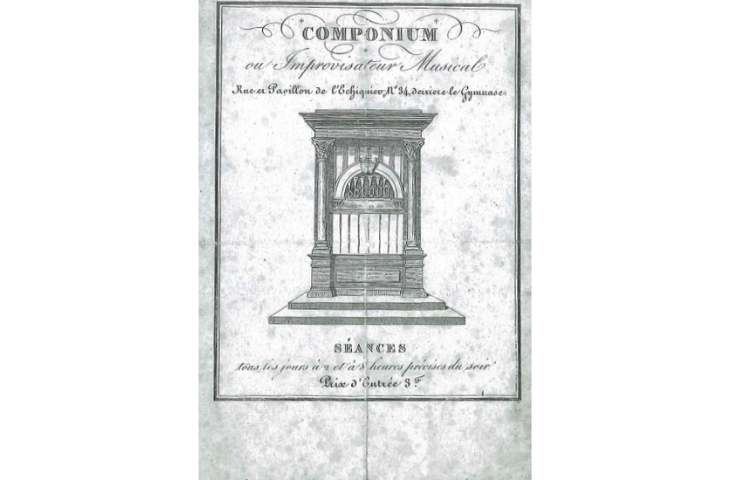April 2023
Fig.1

Componium, Diedrich Nicolaus Winkel, Amsterdam, 1821, inv. 0456
Fig.2

Random switch mechanism
Fig.3

The Paris cabinet
A revolutionary invention
In 1821 the Amsterdam watchmaker Diederich Nicolaus Winkel (1777-1826) built an instrument which became known as the first aleatory, self-composing musical instrument. The Componium, owned by the MIM since 1879 (inv. 0456), fascinated fashionable Paris and London audiences in the 1820s, but was neglected, forgotten, mishandled and almost destroyed in the decades following its success. The Componium is now on show in the Musical Instruments Museum of Brussels (MIM) as one of the masterpieces of the collection (fig.1).
Winkel’s Componium is an orchestrion, a large sized barrel organs that has the ambition to sound like an orchestra. To obtain that goal, they count on the timbre possibilities of an organ, supplemented with real instruments, such as percussion instruments, trumpets and reed instruments. The Componium can be played in two different ways: as an orchestrion and as a componium. Three barrels are now available for the orchestrion part: Wolfgang Amadeus Mozart’s overture to Die Zauberflöte (1791), Louis Spohr’s Notturno (1815), and Ignaz Moscheles’ variations on the Alexander Marsch (1815).
However, apart from its function as an orchestrion, the componium was also able to ‘compose’ music, that is, endlessly present new variations. This required 2 barrels, rotating simultaneously, and containing music consisting a theme with seven variations. The music is spread per two measures over the two barrels, so that measures 1 and 2 are notated on the upper barrel, measures 3 and 4 on the lower one, and so on, until the last bar (80 in total). When activating the instrument, the basic theme is played. After that, the Componium begins to ‘compose’. When a barrel plays the first two measures, the Componium ‘autonomously’ decides which two measures on the other barrel will follow, and vice versa; whenever a barrel is in the silent zone, a “random switch mechanism” decides whether or not the barrel will move (fig. 2). T
his mechanism, that turns the Componium into an aleatory instrument, was a revolutionary invention when it premiered in 1821. Because the instrument also sounded good and all harmonic rules were respected, it could count on many music lovers and mechanical instrument admirers in the 19th century.
Presentation to the public
After its premiere in Amsterdam in 1821, the Componium was presented to the Parisian public in December 1823 in the "Pavilion Wenzel". The instrument was presented as a musical curiosity and attracted a great deal of interest. However, a decorative cabinet had been built around the instrument, which caused some suspicion (fig. 3). To get rid of all the gossip and discussions, the owners of the Componium (who bought the instrument earlier from Winkel) allowed a select group of specialists and enthusiasts to examine the instrument for its authenticity. Their report was a moral victory, and a recognition of Winkel's genius.
At the beginning of 1826, the Componium could be admired in the café-restaurant "Le Café du Componium". However, that same year, the instrument disappeared from public life. The instrument was dismantled and stored in a room near “La Barrière du Trône”, where it remained until the end of 1828, exposed to temperature and humidity fluctuations. Mr. "D" bought the Componium at auction in 1829 and shipped it to London the next year. Once again the Componium could count on a lot of support, but only for a short period of time. The death of King Charles IV threw sand in the gears. Because of the uncertainty about the duration of the mourning period, the owner of the Componium chose to fly ahead and sent the Componium back to Paris. However, the move back to Paris did not go smoothly. Problems with customs meant that the Componium had to stay in England, to be kept in bad conditions (again).
Restauration of the instrument
In 1831, and the Componium was once again back in Paris, "D" entrusted the restoration of the instrument to the watchmaker, magician and illusionist Jean Eugène Robert-Houdin (1805-1871). He had no idea what he was getting into. Through trial and error, in 1832 he nevertheless claimed that the Componium had risen from its ashes like a phoenix. Quod non! Eventually "D" sold the Componium to Mathieu de Livran (1800-1872), but we don't know exactly when. He owned the instrument until his death, long enough to mismaster the Componium. According to Victor-Charles Mahillon (1841-1924), "this imprudent amateur set out to piece together one of the most complicated things in mechanical construction … Needless to say, none of it worked". All hopes of restoring the Componium now seemed pinned on the Parisian organ builder Aristide Cavaillé-Coll (1811-1899). He owned the instrument until 1876, but did not find the time to start this feat. The French cellist and violin maker Auguste Tolbecque (1830-1919) took over and finished the job in 1879.
In the same year, the Brussels Instrument Museum bought 116 instruments from Tolbecque's collection, including the Componium. Apparently, the instrument played well when purchased, but an urgent restoration was already necessary at the beginning of the 20th century. Once again the Componium had suffered from less than ideal storage conditions. Over the course of the century, the instrument was not restored to a playable condition. A last attempt dates from the early 1960s, when the Viennese technician Richard Krcal took care of the instrument. He got the instrument working again (and a recording has even been preserved), but the sound quality can be discussed.
The Componium today
With the opening of the new Musical Instruments Museum in 2000, the Componium was exhibited in the new set-up, among other mechanical instruments. Only in 2020 the Componium did receive a thematic upgrade. The instrument is now part of the chronological theme, “The history of European musical instruments”, set up within the topic “Experiment and Innovation”. Of course, mechanical instruments were poor nor inferior neighbors, but being flanked by the instruments of Adolphe Sax and the many valve instruments from the 19th century does more credit to the Componium.
Regardless of everything that went wrong during the various restoration attempts, we have to admit, on the one hand, that it is because of people such as Robert-Houdin, de Livran and Tolbecque that we still have a Componium to exhibit at all. On the other hand, we have to concede that the instrument should have already had its last restoration (in the sense of "making playable") before 1879, the year in which the Instruments Museum became the owner.
Better to leave the Componium alone now, because for all good intentions, we all know that the road to hell is paved with it. It's a cliche, but unfortunately it also worked for the Componium.
Text: Wim Verhulst